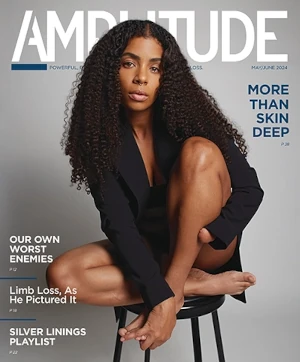For better or worse, for richer or poorer, in sickness and in health—these wedding vows signify a partnership. Yet it is not until they are tested that the meaning becomes evident.
By Laura Fonda Hochnadel • Images by Heather Swanson
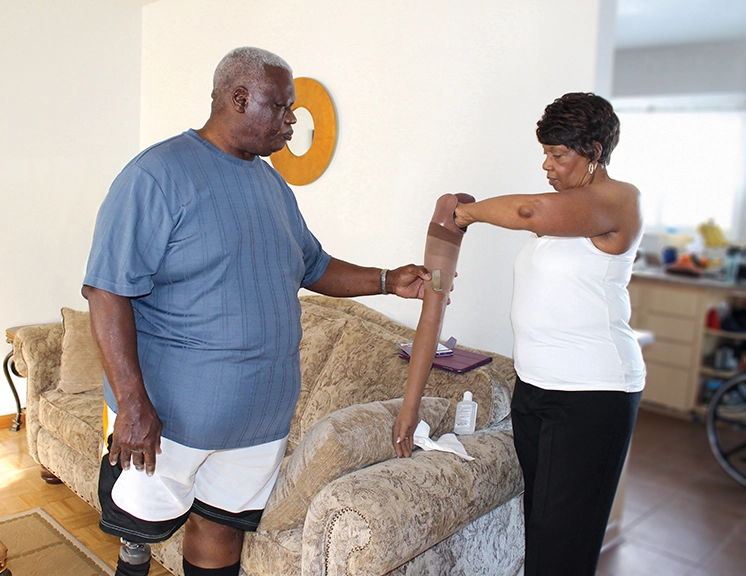
“It feels like a blood pressure cuff.”
Just ask Mary and Larry James, ages 73 and 70. Married for 35 years, the couple met while working in a civilian capacity at Fitzsimons Army Medical Center, Aurora, Colorado. They are both now retired, but at the time, she was a nurse and he a nurse’s assistant. It was Mary’s second marriage; she has two sons, who were 15 and 4 years old at the time. Larry helped raise the boys, helped care for Mary’s ailing mother, and shouldered his share of the household chores, Mary says.
The photos on their mantel tell the story of a happy, loving family that has grown to include a daughter-in-law, three granddaughters, and a grown niece they raised from age 13. Although their family is now separated by several state lines, they are close-knit.
These two have definitely been tested when it comes to their health; each has had a limb amputated. Larry’s right leg was amputated above the knee in 2002, and Mary lost her right arm, just inches below her shoulder, in a car accident in 2014. By leaning on each other and their faith, family, and friends, they are flourishing.
“I trust God,” Mary says. “He’s gotten me through a lot more.”
A MATCHED PAIR
“Larry has the arms, and I have the legs; we’re a matched pair,” Mary jokes.

She’s sensitive, however, to the effects illnesses and injuries can have on a man compared to a woman, especially when his livelihood is affected. “For the time he was recovering from his amputation, he asked, ‘Are you going to leave me?’ and I said, ‘Are you crazy? For better or for worse.’”
When I arrived to meet them at their home, Larry answered the door while Mary was upstairs finishing getting ready. She was having difficulty putting on her prosthetic arm—not a usual occurrence, she later explains—and called to Larry for help. A few minutes later, they come downstairs together, but Mary fidgets with her prosthetic arm, and it’s evident that it is still not secure. Larry comes to her aid again, taking the arm when Mary hands it to him. She then adjusts her prosthetic sleeve, smoothing out the wrinkles, and takes the arm from him. Using an iPhone app, she tries again to secure her prosthetic arm, which uses 5280 Prosthetics’ SmartPuck™ decompression socket system to stay in place.
“I have both arms,” Larry says. “I can do more than she can do. She can walk faster than me. That’s about it.”
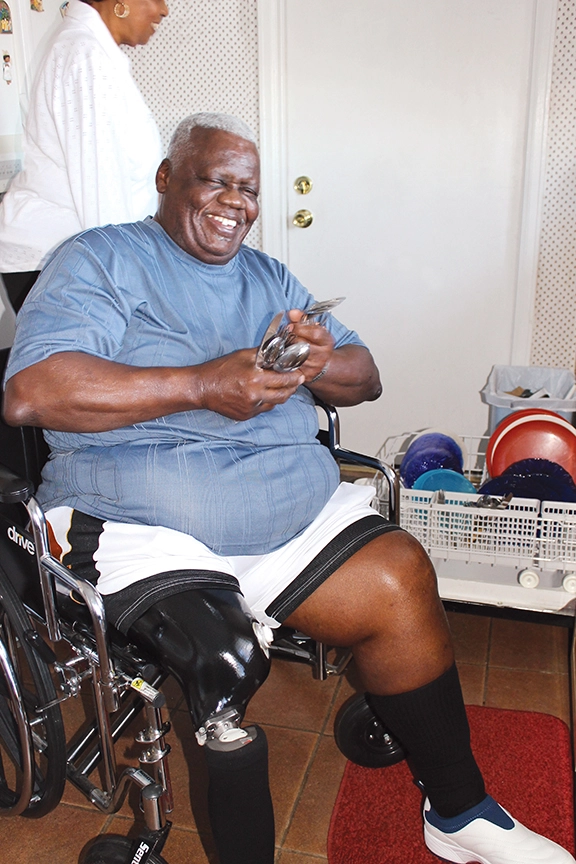
The couple have learned when to step in to help the other and when to ask for help themselves. They also have come to realize that it is equally important to know when not to help or when to nudge the other into action. For instance, when Larry was recovering from his amputation, Mary says she realized if she did less for him, he had to do more, like encouraging him to have his meals in the kitchen with her rather than serving him upstairs in the bedroom. They have a split-level house, which initially posed issues for Larry.
“So I started in,” she says. “I said, ‘If you want to eat, come on down. I’m not bringing it up to you.’” Similarly, she has to stop Larry from helping her at times. “Sometimes I have to say, ‘Just let me do it.’ I know it may take me a bit longer, simple things like fastening my pants, but sometimes, especially when we’re ready to go to church, I just go and say, ‘Okay, fasten me up.’”
These lessons seem to have served them well.
Larry’s story dates back to a 1964 football injury. “I tore my knee up my first year of college, and they told me I couldn’t play anymore,” he explains. So he switched gears and went into nursing. However, it was a knee replacement revision surgery in 2000—necessitated by that decades-old injury—that eventually became infected and led to the amputation after 17 months and four major surgeries to try to save his leg. Robert Meier III, MD, with Amputee Services of America, Denver, was his amputee consultant. Bill Allen, CP, owner of Without Limits, Denver, fitted Larry with the Ottobock C-Leg he now wears, which he says allows him to walk with a normal gait.
“I knew that even when they said they had to take his leg, even though it was going to be a big adjustment, that he wouldn’t let that stop him,” Mary says. “It took him a while, but he went back to work.”
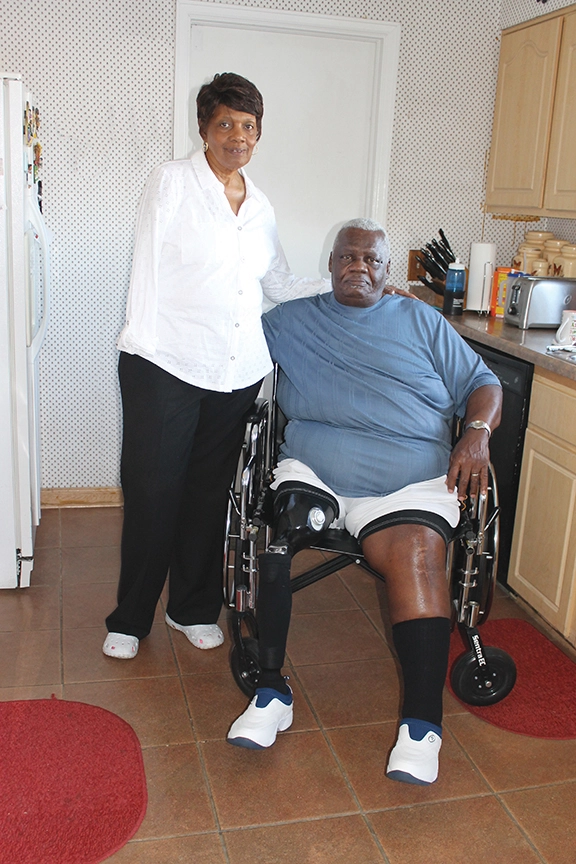
Mary’s arm was completely severed in a car accident on December 21, 2014. The couple was returning to their Aurora home from the airport after picking up several family members who were visiting for Christmas. “A young lady was texting and driving, and she lost control of her car…and tipped us over,” Mary says softly, with a long sigh.
“Four times,” adds Larry.
Their niece’s arm was crushed. Their granddaughter, who was 9 years old at the time, sustained a closed head injury. Larry and the niece’s boyfriend received minor bumps and bruises, leaving Larry in a position to advocate for his wife’s care. She was rushed to University of Colorado Hospital for emergency surgery and afterward was transported to Denver Health Medical Center where the others were receiving care.
“We were at Denver Health, and they wanted her to see their amputee person to follow up with her arm, but I didn’t agree with them,” Larry says. The emergency surgery had left Mary with the remaining part of her arm sutured to her underarm, with no residual limb. Through his amputation and recovery, Larry had grown to trust Meier and wanted to entrust Mary to his care also. “I wanted Dr. Meier to take care of her so we went and saw him,” Larry says. Meier organized Mary’s revision surgery, so she would have a residual limb and could then be fitted with a prosthesis.
“They made a V to release the arm from my underarm, which is why it’s so dreadfully short,” Mary explains.
PROSTHETIC TEAM RALLIES FOR MARY
With Mary’s extremely short residual limb, Meier knew it would take a special team to fit her with a prosthetic arm. He referred her to Handspring’s Denver office, where she met Erik Tompkins, CP, BOCO, and Thomas Passero, CP, president and clinical director of Prosthetic & Orthotic Associates, Handspring’s parent company.
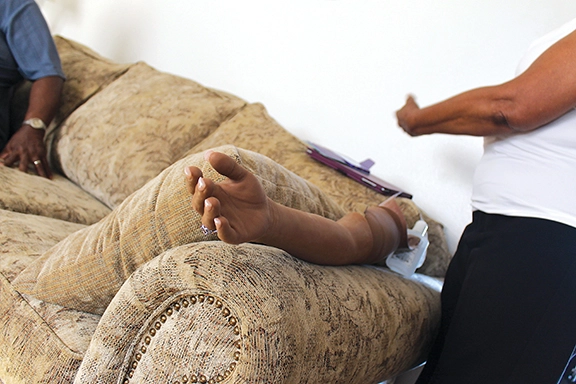
Mary directed what she wanted, and they listened, Tompkins says. “She didn’t want anything to do with harnessing, and she didn’t want a sophisticated prosthesis, just a passive device that she could wear…and have her hand out there and welcome fellow parishioners into her church.”
Through Tompkins’ years of experience, he knew an active vacuum or suction suspension system was the route to go. He had a custom liner made by Chris Lake, CPO/L, FAAOP, owner of Lake Prosthetics and Research, Euless, Texas. The liner is broader and has a tackier seal than traditional ones. Clint Accinni, CPO, and Royce Heck, CPO, founders of 5280 Prosthetics, Littleton, Colorado, were also called in to help; it was the first time their SmartPuck system was applied to an upper-limb patient.
“We got the right people in the right places to make the right decisions, and it all came off really well,” Tompkins says.
FLOURISHING
A bowler since elementary school, Mary is now learning how to bowl with her left hand. She has worked up to an 88 average; Larry resumed bowling three years ago and carries a 170 average. Larry fishes and Mary goes to water aerobics. They are actively involved in their church, where Mary teaches Sunday school and sings in the choir. They go to lunch with friends and are often surrounded by family.
Larry shares their secret of staying active: “It’s just the thing of doing what you want to do, what you’re used to doing.”


